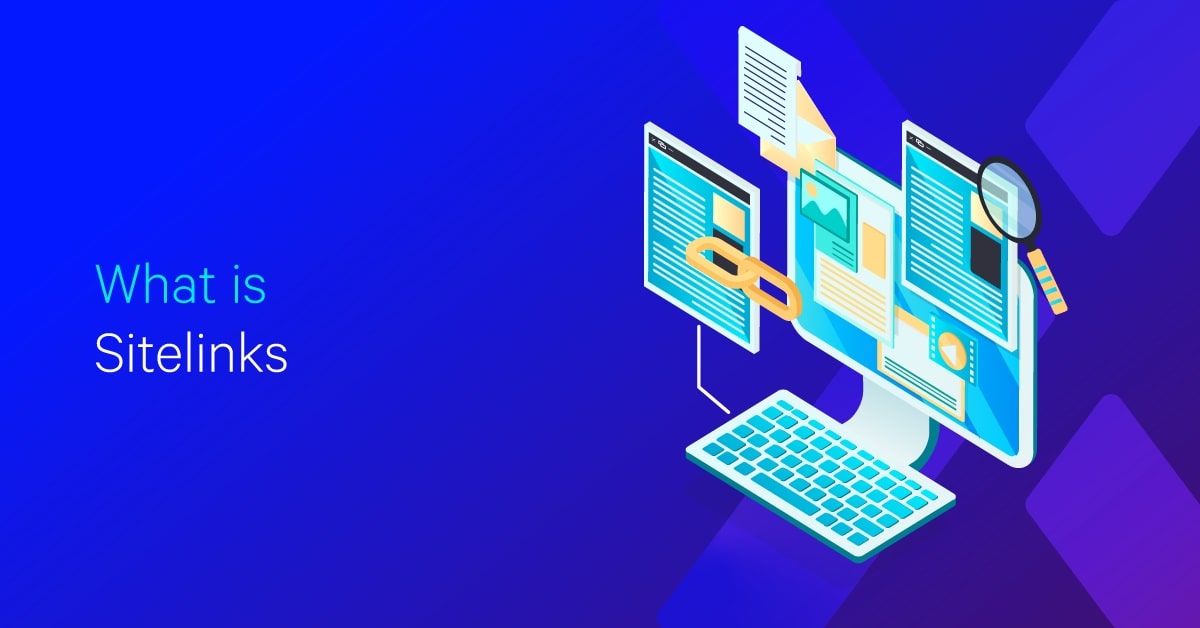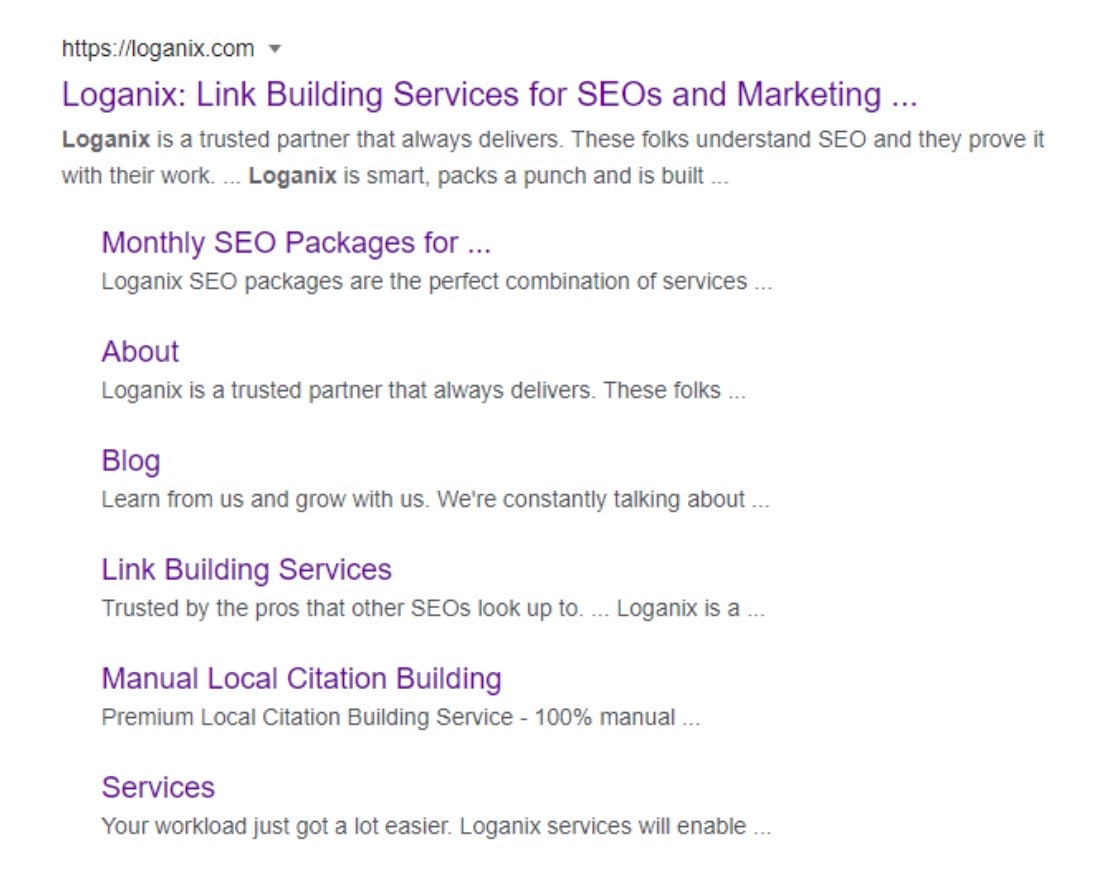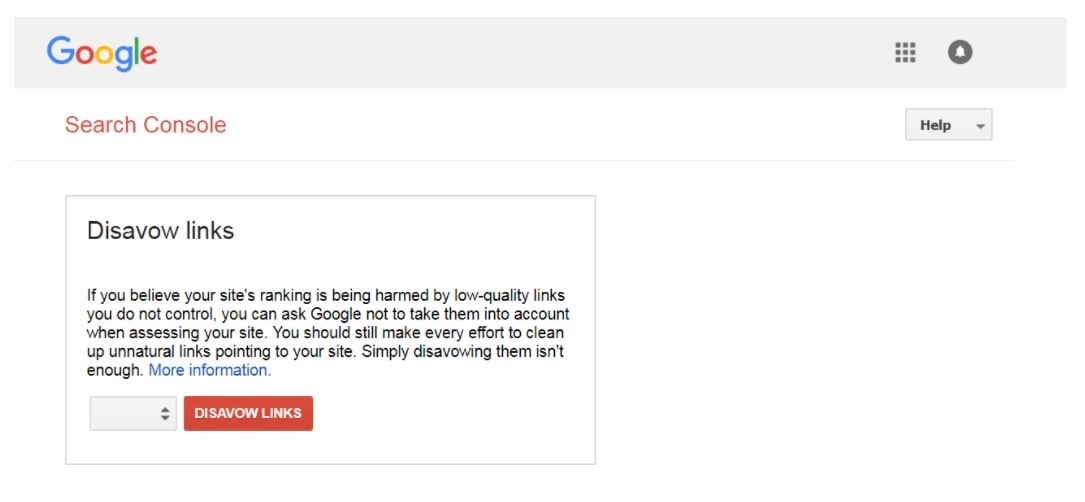What Are Sitelinks?

Hand off the toughest tasks in SEO, PPC, and content without compromising quality
Explore ServicesAs a marketer, you understand the significance of high search engine rankings.
This is how you obtain highly focused organic traffic on autopilot for months or even years.
While rankings are crucial, more individuals clicking on your sites in search engine results is also necessary.
Google Sitelinks is one method for increasing your CTR.
But what exactly are Google Sitelinks? How can they assist your website? Most importantly, how do you obtain them?
In this article, we’ll delve into what sitelinks are, why sitelinks are important, how to remove sitelinks from Google, how to get rid of unwanted links on your website, and how to change sitelinks in Google.
Let’s get this party started.
What Are Sitelinks?
Sitelinks are the additional links that appear below the primary URL in Google search results. These are used to give consumers quick access to several Web sites on your main website. The basic aim of sitelinks is to assist people to browse your website more easily.
Sitelink extensions, which have a similar aim, are mostly utilized in Google Ads. Sitelink extensions are distinct from organic sitelinks in that Google AdWords users have total control over not just the content of these links but also whether or not they appear in the ad.

Sitelinks come in a variety of forms:
1. One-line sitelinks
One-line sitelinks are a common type of sitelink. These can have up to four links and occur in a variety of search queries. One-line sitelinks vary from others in that they can utilize fragmented links to guide readers to other Web sites or to specific information within a Web page. Websites frequently utilize these to lead users to a page that has information on the relevant search phrase.
2. Organic Sitelinks
Organic sitelinks are typically utilized for branded phrases and can contain up to six sitelinks to different pages on your website. These sitelinks are typically seen in the top search results.
It is a regular occurrence for a person who has searched for your website to not instantly land on the homepage of your website. They could be looking for another Web page on your site that is related to their search term. Google organic sitelinks lead readers to these Web pages that are related to their search queries. This also allows people to browse your website and uncover material that they were unaware existed. This boosts the number of organic clicks to your website.
3. Sitelinks search box
Sitelinks search box is a form of sitelink that allows visitors to search and immediately access the search results of the website on the SERP itself. It is mostly utilized by large companies. Google adds it to the results automatically. However, companies should be aware that simply having a sitelink search box on their homepage does not guarantee that it will show in Google search results.
What Google has altered about sitelinks
Until October 2016, Google gave site owners a tiny amount of flexibility over the sitelinks they might show for their website, with the specific pages that they want. Google permitted this since the Google Search Console offered site owners the “demote sitelinks” function.
Site owners may use this feature to tell Google which URLs they didn’t want to show as sitelinks beneath their main URL.
However, later that year, Google Webmaster stated that the “Demote Sitelinks” option will be removed from the Google Search Console. “Over the years, our algorithms have grown much better at identifying, generating, and presenting relevant sitelinks, and so we feel it’s time to simplify things,” they added.
They expanded on this by stating that Google displays sitelinks to users in search results only when the algorithms believe they would be beneficial to them. As a result, the structure and navigation of your website will be critical in getting Google’s algorithms to discover and show good sitelinks.
Sitelinks are now presented in search results based on their rating on the web. This means that site owners may affect the Web rankings of sitelinks in the same way that they can impact the Web rankings of other Web pages.
Why Are Sitelinks Important?
1. Sitelinks help to increase trust and trustworthiness.
Sitelinks are an essential measure for determining a website’s credibility. When you see Sitelinks on a website, it means that Google believes the website is trustworthy enough to provide Sitelinks.
Sitelinks would not appear if you searched for an obscure, unpopular site with low trust ratings.
What about a site with the polar opposite attributes? Sitelinks are likely to appear.
Understand that Google is well aware that Sitelinks occupy virtually the whole above-the-fold screen real estate. This moves all search results below the fold.
Because Google is devoted to providing the greatest possible user experience for its consumers, it would not want to push an untrustworthy link above the fold. Google’s algorithm isn’t flawless, it makes mistakes. But things are getting better all the time.
2. Sitelinks allow users to navigate further inside the site.
When a person enters your website, they are likely to look at the homepage, product, and service pages. They may view 4-5 pages of your website before deciding to quit.
Will they go to your most popular blog post? Or will they go through the landing pages or resources page to locate the one that offers you the highest conversions?
Most likely not.
However, with Sitelinks, these popular links will appear in search results, delivering traffic to your most important pages.
Inbound (SEO, blog content, etc.) is the top quality lead source for 60% of marketers.
3. Sitelinks raise brand awareness and product recognition.
Sitelinks often point to the most significant pages on your site (as seen by Google), taking into consideration the number of internal links.
Typically, this will be your ‘about’ or ‘product’ pages. As a result, Sitelinks are an excellent approach to educate people about your products and raise brand recognition.
4. Sitelinks boost CTR (click-through rates)
Aside from rankings, one of the most important aspects in successfully generating organic traffic is your CTR. The first three results account for almost 55% of all clicks on average.
These figures do change over time. But, as an example, consider the following:
If a term has 10,000 searches per month, the first result receives 3,124 clicks. Assume that the first result also receives Sitelinks. Because the Sitelinks now occupy the top half of the page (above the fold), the first result receives 20% more clicks. This equates to an additional 2,000 clicks each month – not bad, is it?
In fact, according to one case study conducted by PPC-Hero, Sitelinks improved CTR by over 64%.
Keep in mind that sitelinks appear in sponsored search results as well. One study discovered a direct relationship between sitelink visibility and CTR. CTR dropped from more than 20% to almost 10% once the advertiser ceased advertising Sitelinks.
As a result, the number of leads decreased. The takeaway is that if you want more visitors to click on your site in search results or advertisements, you should obtain Sitelinks.
Sitelinks FAQ
How do you define sitelinks?
Sitelinks are links to other pages (or portions of a page) that appear in the search results of some Google searches. They assist visitors in swiftly navigating important information on a website. Sitelinks initially emerged in 2005 and were made public in 2006.
One of the most frequent search features is sitelinks. In Ahrefs’ US database, they appear in 1.8 percent of SERPs. Sitelinks occur on nearly every branded keyword, and they also appear on many other inquiries, such as informative queries. In fact, sitelinks appear in approximately 67 percent of all organic keywords for Wikipedia.org.
How do I see sitelinks in Google results?
Overall, the greatest advice on how to obtain sitelinks for your website boils down to having a high-quality site that Google can simply scan. In the passage above, Google states that the “structure of your site” must allow its algorithms to identify excellent sitelinks or it will not display them.
Fortunately, the measures you can do to increase your chances of acquiring sitelinks will all enhance your overall SEO (Search Engine Optimization) and make your website simpler to browse for visitors. You could discover that you’re already performing a few of them.
1. Rank first in search results for your brand name.
To some, this may seem obvious, but the most fundamental need for obtaining sitelinks is that you be the top-ranked search result when someone searches for your brand or website name. Google does not give sitelinks to the second, third, fourth, or any other lower-ranking SERP positions.
For example, if I search for Wired magazine from the United Kingdom, the UK publication – wired.co.uk – ranks first for its brand name and receives sitelinks, but the US site, wired.com, ranks lower.
If you’re having trouble ranking #1 for your brand name amid other websites with similar or the same name, rebranding to a more distinctive name or URL may help you get there.
2. Create and submit an XML sitemap.
A sitemap is exactly what it sounds like: a map of your website that identifies every page on the site and can be built for users or search engines, in both instances to assist them in navigating the site.
In this situation, we’re talking about a file housed on your website’s server that informs search engines about the arrangement of your site’s content and helps search spiders to explore your site more intelligently.
The Google Search Console Help Center offers a set of steps for creating and submitting a sitemap. However, if you have a WordPress site, you can sit back and rest because a sitemap is already produced and uploaded to search engines for you.
Other measures you may take to assist search engines to scan your site more quickly and accurately are as follows:
- Make your site’s structure and hierarchy as obvious and logical as possible, with your homepage serving as the “root” page (the starting point).
- If you have any legacy structures on your site that make navigating difficult or time-consuming, now is the time to update them.
- Make sure your website’s main menu contains just the most crucial categories.
- Throughout your site, include relevant and correct meta tags (meta descriptions, title tags, and alt text).
- Avoid weak, insubstantial material, duplicate content, and, of course, keyword stuffing tactics that appear spammy.
- Make use of internal linking that has clear and useful anchor text.
Make sure your site’s pages are well-linked to one another, especially those you want to display as sitelinks — When determining the significance of pages for sitelinks, Google considers the amount of internal/external links. - Fetch as Google may be used to see if Google can crawl and index critical pages on your website.
- Improve your site’s speed and page load speeds, and make sure it’s mobile-friendly to increase your chances of receiving sitelinks on mobile.
The measures you can do to increase your chances of acquiring sitelinks are mainly simply good overall SEO practices that you should be doing normally.
Keep in mind that there is no guarantee that sitelinks will surface as a result of this, but you will be in a lot better position to obtain them.
How do I remove sitelinks from Google?
We have very little influence over sitelinks that Google displays by default, but we always have the option to block sitelinks that we do not want to appear in search results. In fact, when analyzing your blog sitelink, be sure to check for any undesirable pages that are displayed in your sitelink.
If so, here’s a brief lesson on how to use the Google Webmaster tool to remove undesirable sitelinks.
- Navigate to the Google Search Console tool dashboard.
- Select Search Appearance > Sitelinks.
- Add a link to the page you want to remove from the sitelink index.
- When you click Demote, your sitelink will be deleted in a short period of time.
Remember that this demotion is just temporary, and depending on your site structure, Google may re-add that link in a few months, and you will need to repeat the above method to remove undesirable sitelinks from search.
How do I change sitelinks in Google?
Although the process is currently automated, you may improve your content to comply with Google’s best practices and affect sitelink placement.
Using anchor text and alt text that is “informative, concise, and avoids repetition,” according to Google, is one technique to gain sitelinks on a navigational SERP.
You may see that this is rather ambiguous, which is due to Google’s regular modifications to its sitelinks algorithm in order to better serve the requirements of consumers.
They also don’t want websites to be able to swindle their way into sitelinks when it’s not in the best interests of the user.
How do I get rid of unwanted links on my website?
At this stage, you should have a list of backlinks that you want to avoid hurting your SEO. These are known as ‘disavowing’ links; let’s have a look at how the process works.
Step 1: Save Links to Your Website
You should be able to export a list of all the backlinks to your site using your backlink auditing tool. You should indicate any undesirable backlinks in this list so that they may be deleted or disavowed.
Before disavowing a link, it’s advisable to contact the website owner and request that it be removed. After you’ve eliminated as many harmful backlinks as possible, you may disavow the remainder.
Step 2: Export Unwanted Links to a.txt File
To remove your undesirable links, save your list as a plain text file. You can accomplish this in Windows with Notepad or on a Mac with TextEdit. Simply copy and paste your list’s URLs into a.txt file.
Make certain that this file only contains the links you wish to remove. Otherwise, you risk inadvertently preventing Google from considering excellent backlinks when evaluating your site.
Step 3: Use the Disavow Links Tool to upload your file
You may now use the Google Disavow Links Tool to upload your plain text file. Navigate to the tool and pick your website from the drop-down menu:

Then, under Disavow Links, submit your.txt file. It may take many weeks for the procedure to begin making an impact on the SEO of your site.
Because the links you’ve disavowed haven’t been deleted, you’ll still notice them when you perform another backlinks audit. They will, however, not be utilized by Google to rank your site.
Summary
Hopefully, this article has given you a better understanding of sitelinks.
While getting your ranks up is the initial stage in SEO, influencing sitelinks is a good follow-up. Once at the top of a SERP, trying to enhance your real estate and remove other results above the fold will significantly increase your clickthrough rates and conversions.
While you can’t actively modify sitelinks, you can affect them, so why not give it a shot as part of your digital marketing strategy?
Hand off the toughest tasks in SEO, PPC, and content without compromising quality
Explore ServicesWritten by Jake Sheridan on December 21, 2021
Founder of Sheets for Marketers, I nerd out on automating parts of my work using Google Sheets. At Loganix I build products, and content marketing. There’s nothing like a well deserved drink after a busy day spreadsheeting.





